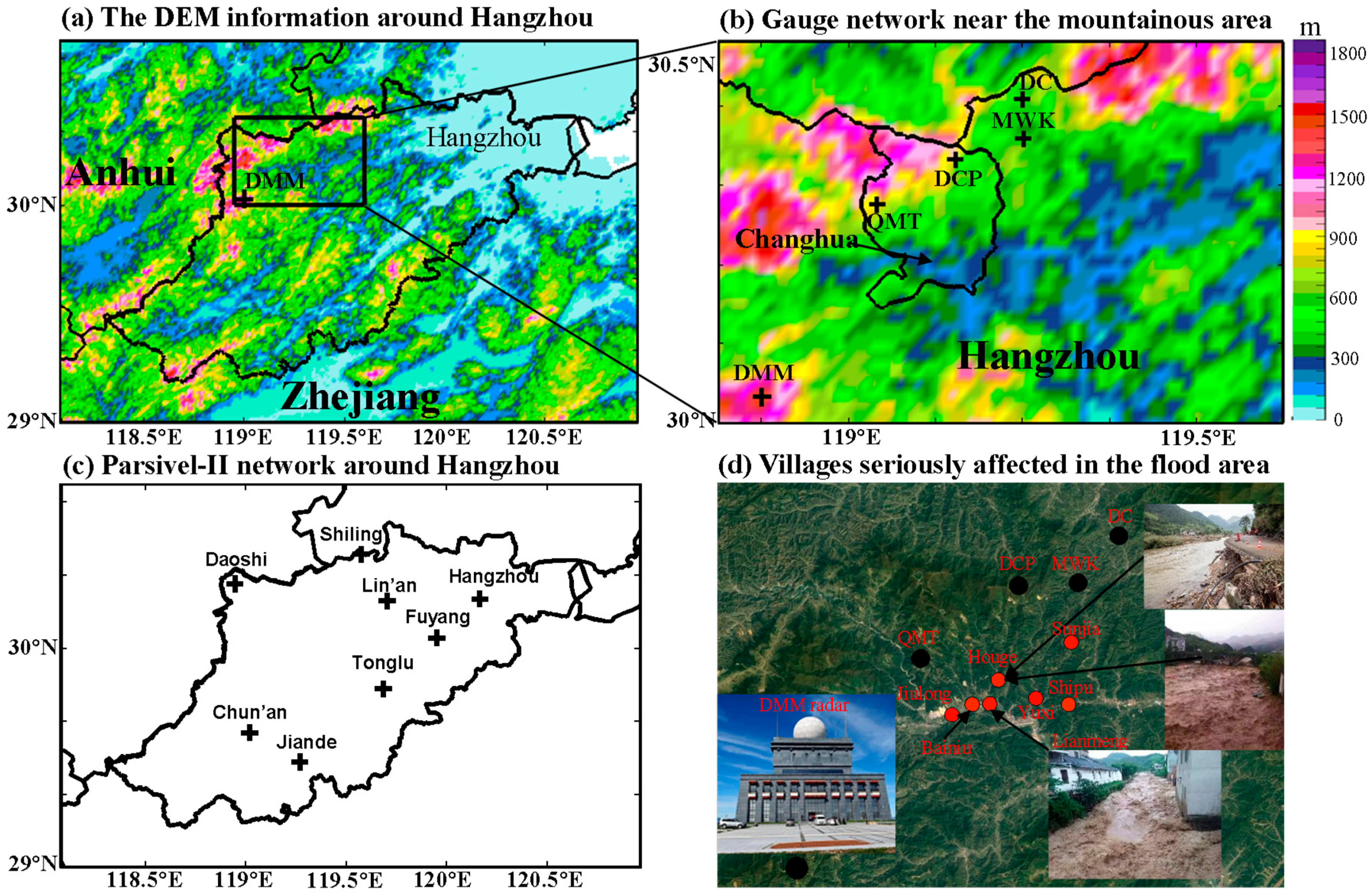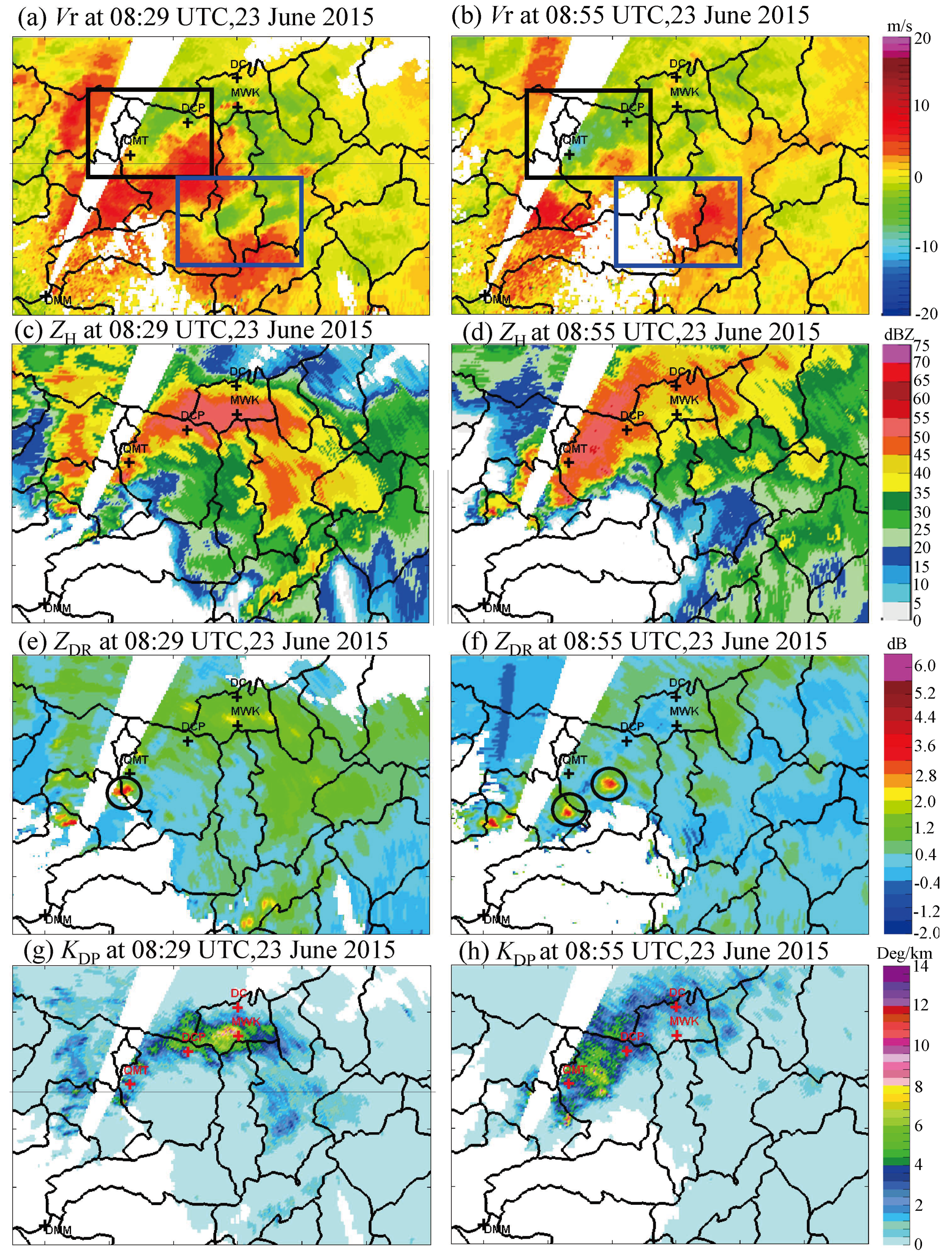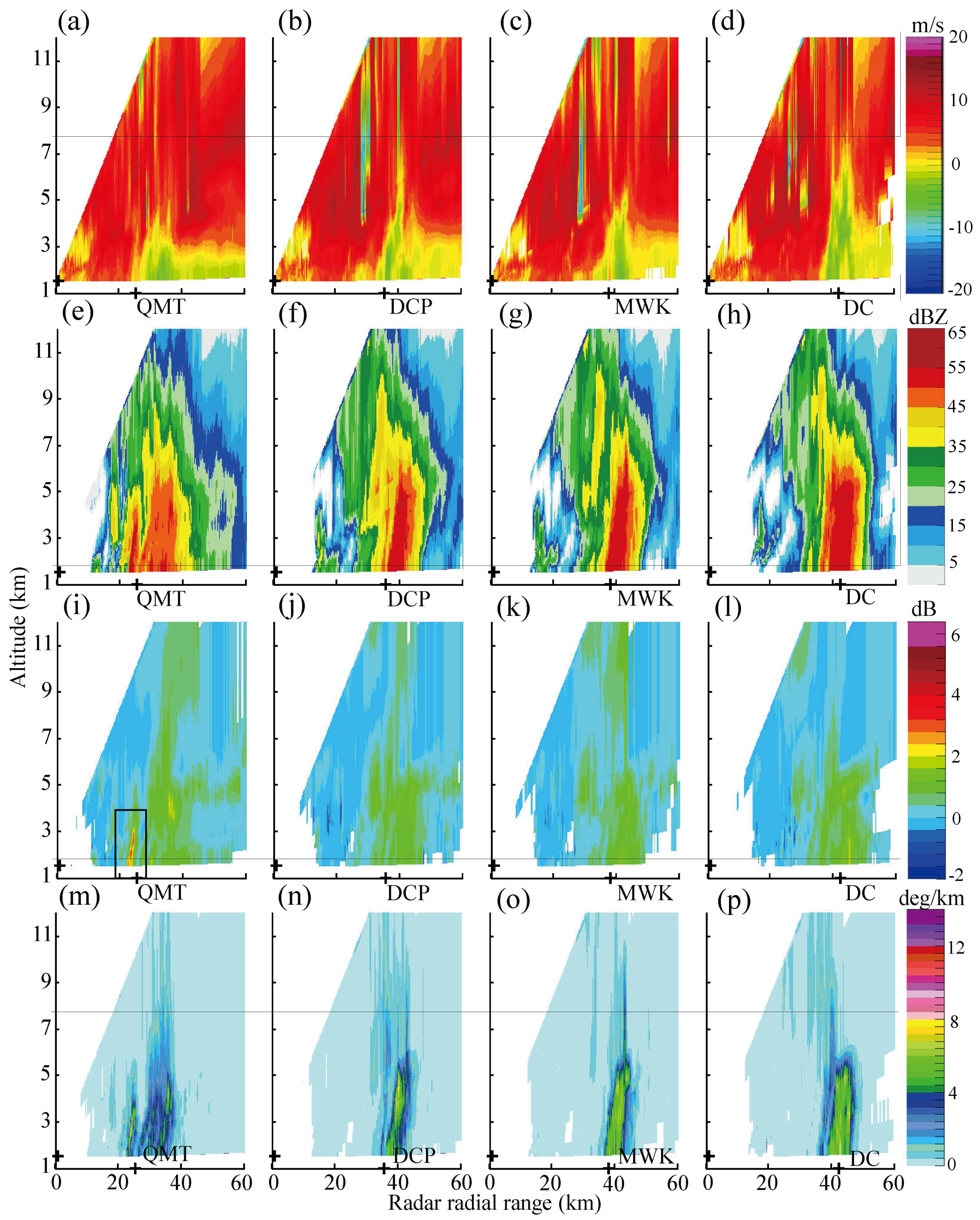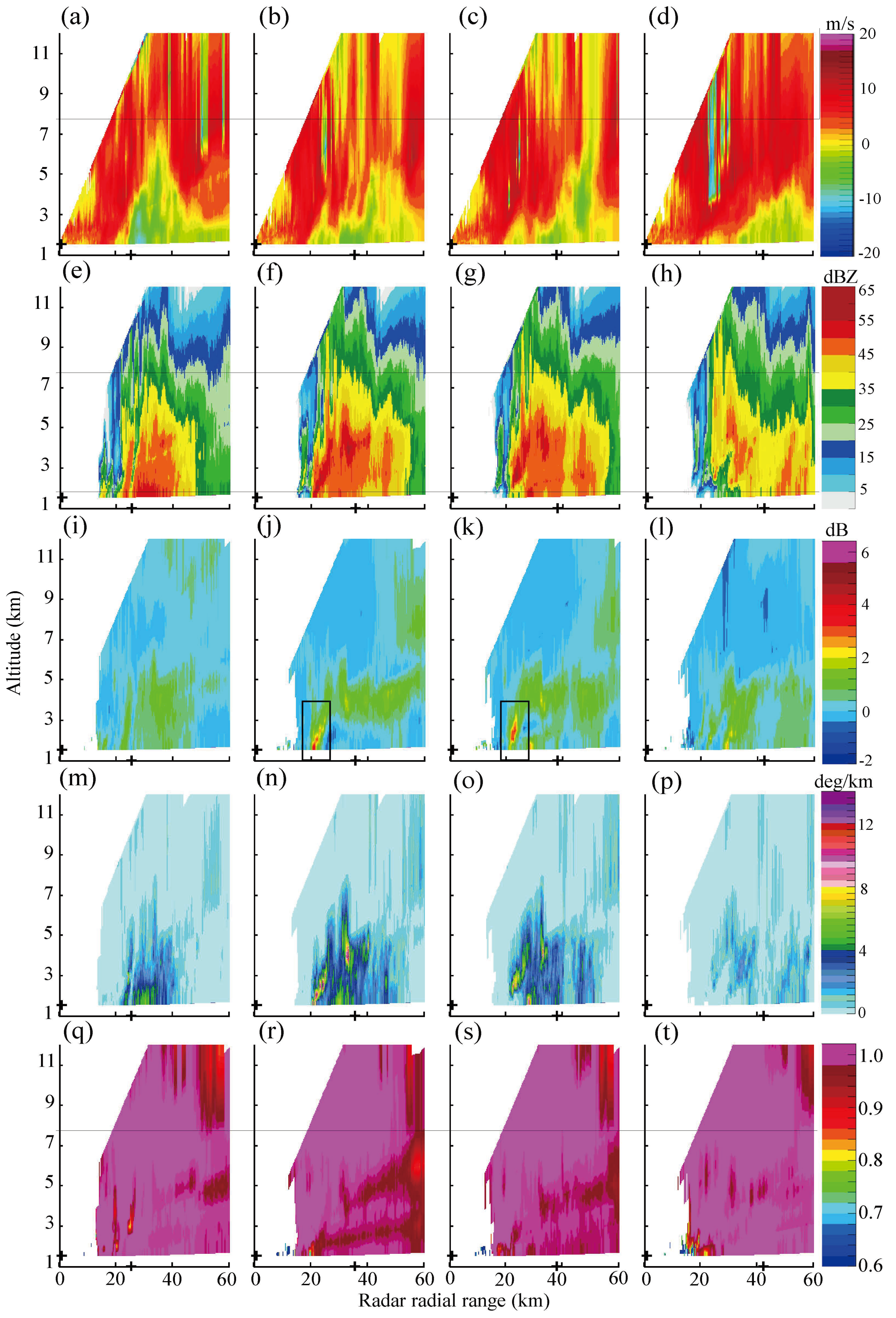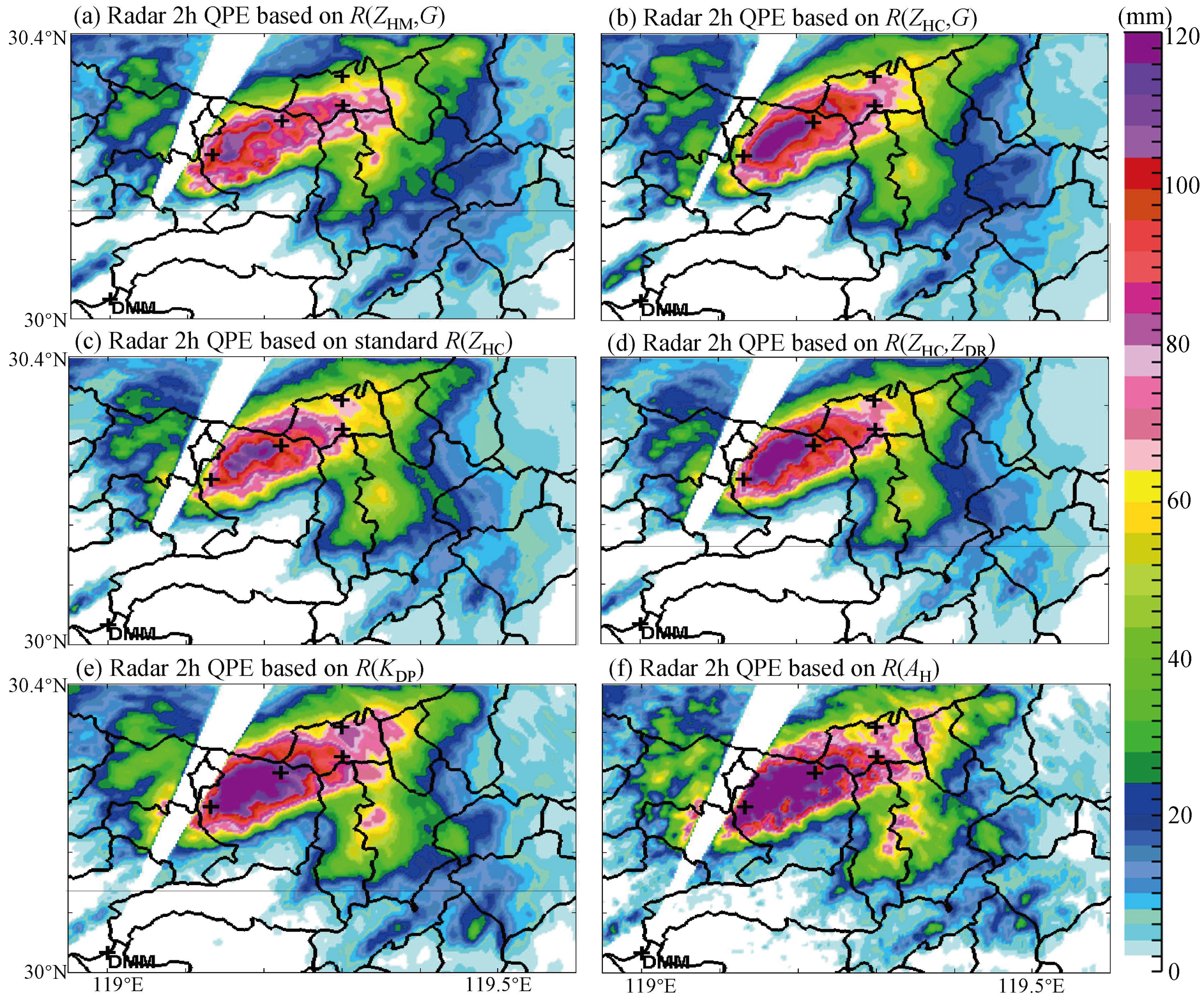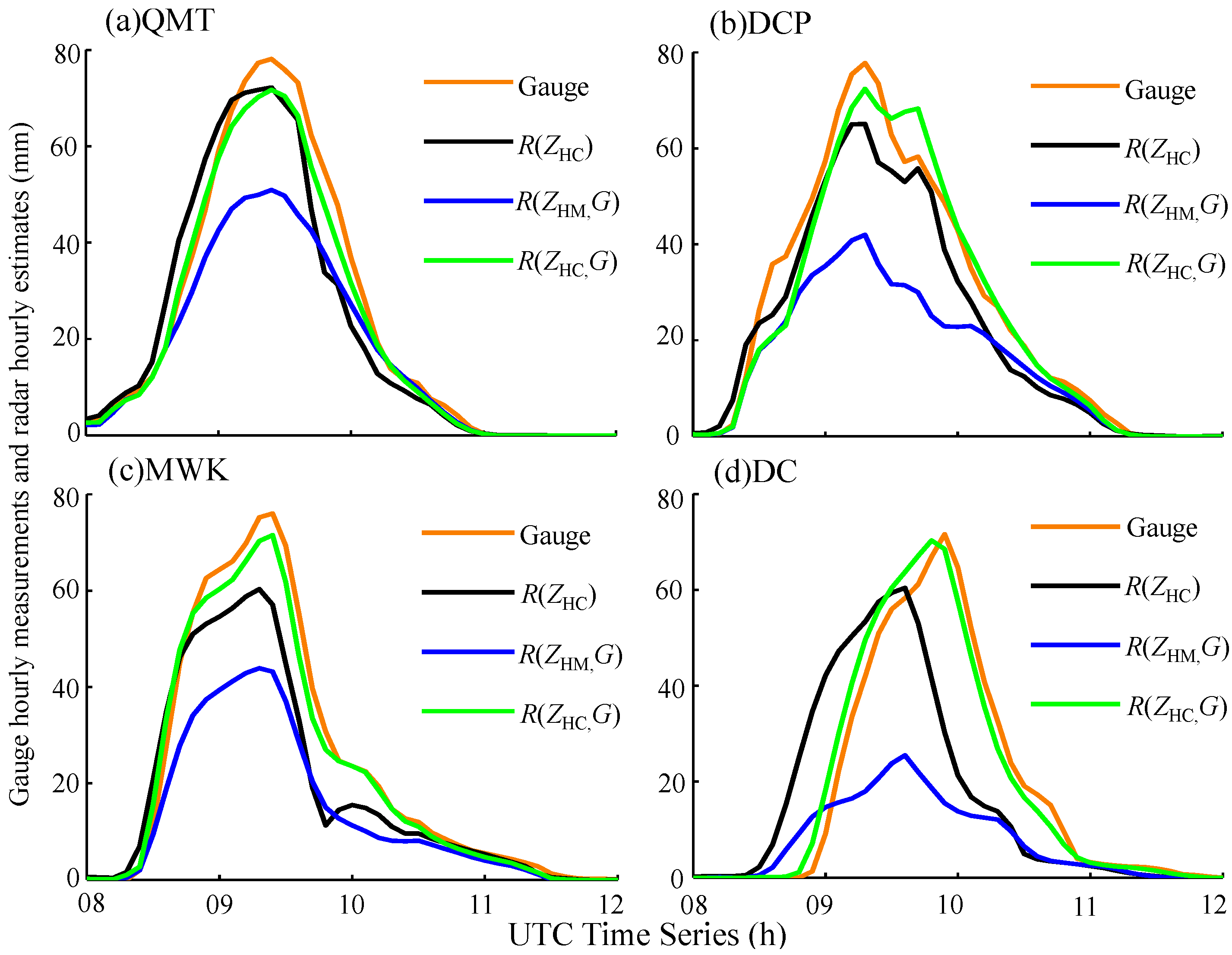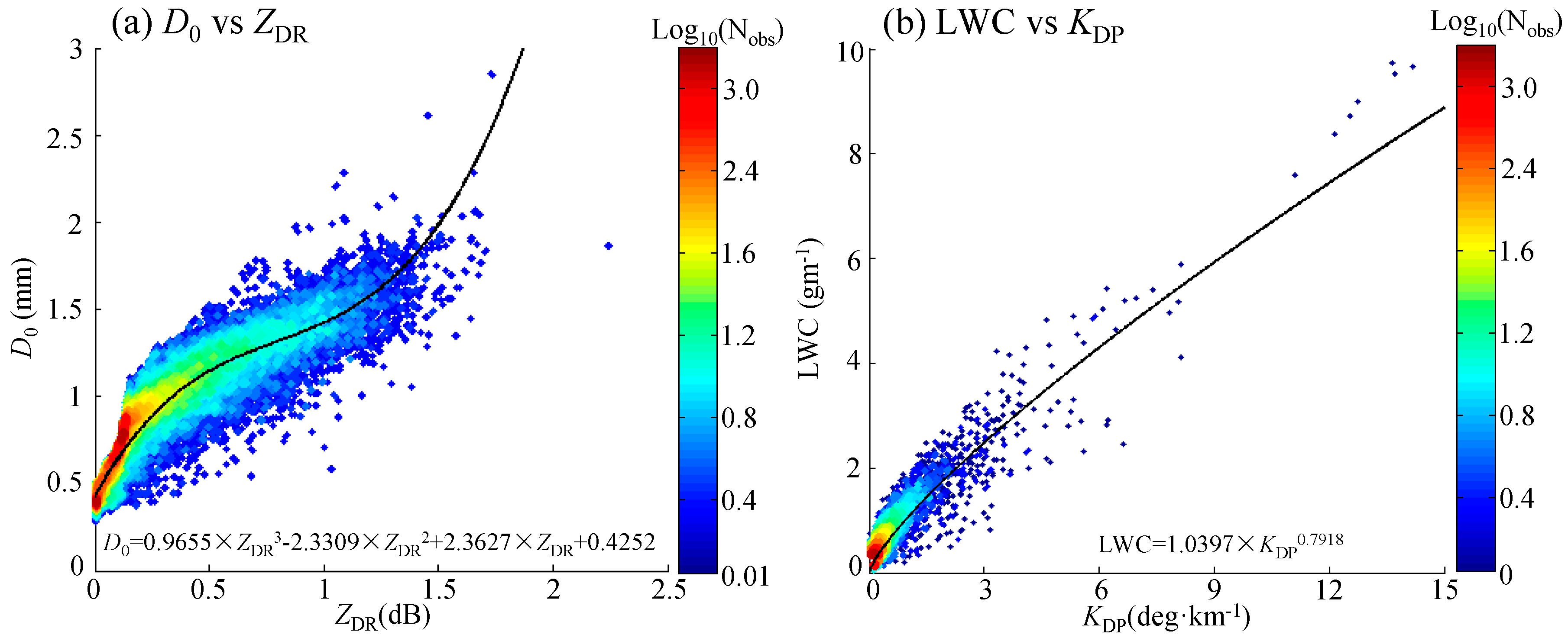3.1. Weather Background
The severe rainfall event that occurred during 0800–1000 UTC, 23 June 2015 (only time will be mentioned afterwards) was mainly caused by a severe convective rainstorm, accompanied by a significant interaction of a mesocyclone with the northwestern mountainous terrain of Hangzhou. The mesocyclone, as shown by the radial velocity (
Vr) data on
Figure 4a, presents obvious positive and negative
Vr pairs near gauge stations at 0829 UTC. These gauge stations began observations of rainfall at that time, and they were all located to the edge of the convergence line of the mesocyclone, which can be seen from the vertical cross-section (VCS) structures of
Vr in
Figure 5a–d. The updrafts within this rainstorm were also quite intense, with the mesocyclone moving towards the mountainous area.
Similar positive and negative
Vr values were distributed around the black and blue rectangular areas on
Figure 4a; the air flow within the blue rectangle evolved quickly afterwards, in comparison with the
Vr spatial structures in
Figure 4b. The negative
Vr values in the black rectangle on
Figure 4b became much larger than that in
Figure 4a, which implied that the mesocyclone was further enhanced since 0855 UTC, due to the lifting effect of the northwestern mountainous terrain. The VCS structures of
Vr were oriented to the gauge stations (see details on
Figure 6a–d), all presenting more severe convective characteristics than that at 0829 UTC, except that orienting to DC (on
Figure 5a–d). The updraft flow upon MWK extended to an altitude of 12 km, as depicted by
Figure 6c, although this state only lasted for a very short amount of time. The downdraft played a dominant role for posterior surface rainfall accumulation, and some hydrometeors above 5 km altitude may have been dragged down to the lower layers after this moment, which aggravated the heavy rain shower upstream of the flood area.
The severe convective rainfall was followed by the mesocyclone. The total rainfall at DCP station was recorded as 33.5 mm over 18 min from 0818 to 0836 UTC, and this accumulated to 48.2 mm in 42 min. The other three stations had similar trends; the rainfall accumulation at QMT station recorded 61.5 mm in 42 min from 0836 to 0906 UTC, the MWK station recorded 60.6 mm in 30 min from 0824 to 0854 UTC, and the DC station recorded 49.6 mm rainfall in 30 min from 0836 to 0906 UTC. However, it is still challenging to accurately analyze the precipitation structure by using this sparse rain gauge network, and it is not sufficient to issue an early flood warning according to these measurements. Therefore, polarimetric radar measurements and QPE products play an indispensable role for severe rainfall diagnosis and analysis.
3.3. Comparison of Different Radar QPE Approaches
Before establishing the DSD-derived radar rainfall retrieval relationships, the traditional feedback-derived rainfall methodology described in
Section 2.3 was put into the routine meteorological operations. Different from the standard DSD-derived approaches, surface gauge measurements are used as feedback source to merge with
ZH to obtain adaptive radar QPE estimators. Using
ZHM and
ZHC to represent the measured
ZH and the attenuation-corrected
ZH,
R(
ZHM,
G) and
R(
ZHC,
G) can be estimated from
ZHM and
ZHC, respectively. Through utilizing the DSD—simulated dataset, standard DSD-derived polarimetric radar QPE estimators can also be obtained, as described in
Section 2.4, and represented as
R(
ZHC),
R(
ZHC,Z
DR),
R(
KDP), and
R(
AH). Here,
ZDR in
R(
ZHC,Z
DR) stands for attenuation-corrected
ZDR. These radar hourly rainfall estimators are evaluated with hourly gauge measurements, respectively, and then their evaluation score results are compared with each other.
Accordingly, radar 2 h rainfall accumulation fields derived from six radar QPE estimators are depicted in
Figure 7, with four “+” marks representing gauge locations. Similar rainfall spatial distributions can be easily perceived in
Figure 7, except those derived by
R(
ZHM,
G) in
Figure 7a, in which the distortion of the rainfall field is mainly caused by the attenuation effects on
ZH. In contrast to the results derived from standard
R(
ZHC) and
R(
ZHC,
G) on
Figure 7b,c both show very clear rainfall textures that gradually extend from the severe rainfall center to its surrounding areas.
R(
ZHC) and
R(
ZHC,
G) both performed better than
R(
ZHC,
G), from a comparison of the statistical scores in
Table 1, and their
ERMS sores were reduced by 55.7% and 74.9%, respectively.
ENMA was reduced by 52.7% and 74.1%, and
ECC was enhanced by 2.3% and 3.7%, respectively.
R(
ZHC,
G) also performed better than
R(
ZHC), and
ERMS,
ENMA, and
ECC scores were improved by 43.4%, 45.3%, and 1.4%, respectively. The rainfall time series in
Figure 8 presents another similar view:
R(
ZHM,
G) presented obvious underestimations at all gauge stations; the
R(
ZHC) and
R(
ZHC,
G) time series were similar to each other, and to gauge measurements at QMT and MWK (see
Figure 8a,c), but
R(
ZHC,
G) was closer to the gauge measurements than
R(
ZHC) at DCP and DC (see
Figure 8b,d).
The improvements of R(ZHC) to R(ZHM,G) can be attributed to the utilization of the improved ZPHI method and the DSD-derived Z–R relationships. Instead, the superiority of R(ZHC,G) to R(ZHM,G) is mainly attributed to the former factor, because the same fitting scheme as R(ZHM,G) was used, but R(ZHC,G) to R(ZHC) benefited from the dynamically adjusted Z–R relationships. DSD-derived R(ZHC) uses climatically optimal but two fixed Z–R relationships, which may fail if they are not exactly suitable for the special weather events. The ZH threshold in Equations (4a) and (4b) for differentiating rain regimes relies on the assumption that the multiple coexisting rainstorms with similar radar echoes have the same rainfall rates, which are not always in favor if the covering terrain or the underlying surface of the different rainstorms have different environmental characteristics. Instead, R(ZHC,G) adjusts the Z–R relationships dynamically, according to the feedback from the gauge measurements, and it is expected that the spatiotemporal characteristics of the rainstorms can be effectively captured. It appears that R(ZHC,G) benefits more from representative Z–R relationships than R(ZHC) in this severe rainfall event, which implies that it is just not well represented by the DSD-derived Z–R relationships.
As depicted in
Figure 7d–f, the radar 2 h rainfall accumulation field retrieved from the DSD-derived
R(
ZHC,Z
DR),
R(
KDP), and
R(
AH) presented similar rainfall field textures to those of
Figure 7b.
R(
ZHC,Z
DR) and
R(
KDP) both presented better scores than
R(
ZHC) in
Table 1. Comparing with
R(
ZHC), the
ERMS scores of
R(
ZHC,Z
DR) and
R(
KDP) were reduced by 14.5% and 23.8%, their
ENMA scores are reduced by 13.2% and 17.6%, and the
ECC scores were enhanced by 0.2% and 1.3%, respectively. This shows the superiority of the composite utilization of
ZH and
ZDR, and the better representativeness of
KDP than
ZH in the severe rainfall scenarios.
According to the statistical scores comparison in
Table 1,
R(
KDP) performed the best among four DSD-derived polarimetric radar QPE estimators, and
R(
ZHC,
G) indeed performed the best among all of the radar QPE estimators; its
ERMS and
ENMA scores were 26.4% and 33.6% less than
R(
KDP), respectively, and the
ECC score was 0.1% larger than
R(
KDP). However, for
R(
ZHM,
G) and
R(
ZHC,
G) both used all four gauge measurements without dataset partition for cross-validation, their scores in
Table 1 reflect more about the degree to which radar estimates approximate gauge measurements according to Equation (3). Besides, these scores assume that gauge measurements are always the truth, but their measurements may be not accurate enough, especially if the horizontal and vertical wind effects are taken into account, which obviously accompanies the development of the mesocyclone during this extreme rainfall event, and makes the gauge measurements much less than its potential truth. These gauges are all tipping buckets without any wind fences; furthermore, no correction of gauge measurement is routinely done in the meteorological operations, which means that their real values are possibly larger than the current recordings. Therefore, the apparent overestimation of radar QPE estimators would likely be reduced if the wind effects are considered with regard to gauging measurement accuracy. Although the radar rainfall time series of
R(
ZHC,
G) and
R(
ZHC,Z
DR) on
Figure 8 and
Figure 9 were both more consistent with gauge measurements than
R(
KDP),
R(
ZHC,
G) slightly underestimated rainfall at QMT, MWK, and DC stations, and
R(
ZHC,Z
DR) slightly underestimated at DCP, MWK, and DC stations at the peak of the rainfall time series. Instead,
R(
KDP) overestimated at all four stations, especially when the gauge hourly rainfall measurements exceeded 20 mm. Taken in this sense,
R(
KDP) seems more reasonable than
R(
ZHC,
G).
However, three statistical scores of
R(
AH) seemed not to have improved, but were reduced in contrast to
R(
ZHC), and its
ERMS,
ENMA, and
ECC scores became worse by 27.9%, 27.1%, and 1.4%, respectively, which was inconsistent with previous research results [
5].
R(
AH) tended to be consistent with
R(
KDP) at DCP and MWK (see
Figure 9b,c), and
R(
AH) overestimated seriously at QMT station on
Figure 9a, which was located on the near side of the rainstorm relative to DMM radar, but it underestimated slightly at DC station on
Figure 9d, which was located on the far side of the rainstorm. To address this issue, the normalized concentration of raindrops
Nw (mm
−1·m
−3) can be represented as in Equation (6):
where
ρw is the water density (1 g·cm
−3 at 4°C), and LWC (g·m
−3) and
Dm (mm) stand for the liquid water content and the mean volume diameter of the drop size distribution. As for the deduction in
Section 3.3,
ZDR within this rainstorm was nearly the same in 0.5–2dB; namely,
Dm was not very different. However, its near and far sides of the rainstorm were different in LWC, and this phenomenon implied that more raindrops concentrated on the near side between QMT and DCP than that on the far side of the rainstorm. Furthermore, considering that
AH =
αKDP, but that
R(
AH) does not perform the same as
R(
KDP), their performance differences can be attributed to the coefficient
α, which depends on temperature and is prone to DSD variability [
5], and it also can be concluded that
KDP may be superior to
AH in such a scenario. At last but not least, little melting hailstones may exist, accompanying the rainstorm, as in the deduction in
Section 3.3, which are also responsible for the performance reduction of
R(
AH).
Another important phenomenon worth noting is that radar 2 h rainfall field centers of different radar QPE estimators were all above 100 mm (see
Figure 7 and Max(
R2H) in
Table 1), but these rainfall centers were nearly all located within the gap between surface gauge stations. Namely, the gauge network failed to capture the subsequent storm evolution states within the rainfall center area. A reasonable explanation was necessary to demonstrate the confidence of the radar rainfall retrieval results, which was important for the posterior disaster investigation.
3.4. Microphysical Characteristics of the Rainstorm
More microphysical information can be deduced from the spatial and vertical structures of polarimetric radar variables in
Figure 4,
Figure 5 and
Figure 6 of the rainstorm and its severe rainfall centers. Before the data analysis, consistency between
ZH,
ZDR, and
KDP was first verified through the scattergram on
Figure 10, in which scatters of 743 DSD-simulated
ZH,
ZDR, and
KDP pairs were overlaid for intercomparison. It can be seen that the scattergram of
ZDR–
ZH agreed well with the DSD-simulated
ZDR–
ZH distributions on
Figure 10a,b.
ZDR presented a similar tendency, with
ZH increasing, which obeyed the classical liquid raindrops model. The scattergram of
KDP and Z
H was also consistent with DSD-simulated distributions.
Figure 10c,d shows that
ZH increase tends to be consistent with
KDP increase, which is immune to attenuation and miscalibration. The consistency between
ZH,
ZDR, and
KDP is to ensure their creditability, and to enhance the confidence of these polarimetric variables, as seen in
Figure 4,
Figure 5 and
Figure 6, for subsequent applications.
As shown in
Figure 4c, the plan position indicator (PPI) of
ZH exhibited dense storm structures at 0829 UTC. QMT, DCP, and MWK were just located on the edge of the storm cells at this moment, and they had just begun recording intense rainfall measurements near the convergence line of the mesocyclone. The VCS of
ZH oriented to the four stations presented severe convective structures (see
Figure 5e–h), and
ZH within the storm core area exceeded 60 dBZ, which indicates that the storm cell was strongly developing at 0829 UTC. These were consistent with the significant increasing measurements of the hourly rainfall time series illustrated in
Figure 8 and
Figure 9. The rainstorm is more convective in
Figure 4d than that in
Figure 4c, and the updraft flow was more severe, as described in
Section 3.1. The shape of the rainstorm upon the rainfall center area between QMT and DCP appeared as an effusive eruption structure along the mountainous terrain with a
ZH hotspot. More complex microphysical processes may exist within the rainstorm, which can be further analyzed by using
ZDR,
KDP, and
ρHV.
An important phenomenon accompanying the rainstorm is that big raindrops exist along the mesoscale convergence line, with large
ZDR values (exceeding 2dB) near QMT on
Figure 4e, and at the south of QMT and DCP on
Figure 4f (marked with black circles). As depicted in the rectangle on
Figure 5i and
Figure 6j,k, the large
ZDR columns are obviously related to the large
ZH columns in
Figure 5e and
Figure 6f,g, which are all consistent with the convergence structures of
Vr in
Figure 5a and
Figure 6b,c. These Z
DR columns are caused by the sustaining updraft flow along the convergence line of the mesocyclone [
35,
36]. However, this rainstorm does not present big
ZDR values within most of its parts; conversely, it is mainly composed of small
ZDR values (less than 2dB), which can be seen from both the Z
DR PPI scans and the VCS structures of
ZDR, as illustrated by
Figure 5i–l and
Figure 6i–l.
The scattergram of the median volume diameter
D0 and
ZDR is depicted in
Figure 11a, where Equation (7) is fitted to represent the empirical relation between
D0 and
ZDR. Equation (7) is similar to that in Brandes et al. (2004) [
37], and it works well for 0.25 dB ≤
ZDR ≤ 2 dB.
Small and moderate raindrops with 0.25 mm ≤
D0 ≤ 2 mm may be the dominant hydrometers within the rainstorm. According to the classical cloud microphysics stating that a big raindrop is equivalent to many small-sized raindrops for the same
ZH value within a radial volume, a high LWC and
Nw can account for the big Z
H, but not the small
ZDR areas of the rainstorm, which can be deduced, starting from the exponential relations between LWC and
KDP:
It can be clearly seen from
Figure 11b that
KDP > 3 deg·km
−1 with LWC > 2 g·m
−3 is rare. However, the VCS structure of
KDP columns on
Figure 5m–p and
Figure 6m–p are clearly characterized by high
KDP values that are larger than 3 deg·km
−1. With
KDP > 3 deg·km
−1 and
Dm < 2 mm (maximum of
D0), LWC is higher than 2.4815 g·m
−3, and log
10(
Nw) is higher than 5.1 mm
−1m
−3 within the rainstorm. This provides obvious evidence that the vertical layers of the rainstorm below 7 km are abundant, with the high liquid raindrop concentrations upon the severe rainfall center.
Melting hailstones may be also accompanied within this rainstorm, and it can be obviously seen at 0855 UTC on
Figure 6n,o that a slight
KDP gap column with small
KDP values (less than 1 deg·km
−1) between the storm cores is featured, with a
ZH above 45 dBZ (see
Figure 6f,g), and
ZDR tending to be near-zero and negative values within this
KDP column. It can also be found in
Figure 6r,s that
ρHV is obviously less than 0.98 on the VCS structures of
ρHV. Both the possibilities of big raindrops or dense little raindrops can be excluded. Small
ZDR and
ρHV values are both important microphysical characteristics of hailstones; furthermore, the scatter density in the rectangular area on
Figure 10b shows an incompatible
ZDR–
ZH distribution with the classical liquid raindrop model. This convective updraft flow lasts for very long; little hailstones may be the most reasonable hydrometers within the
KDP gap column, and some solid water content from the upper layers above the freezing level may also be falling in this process. In addition, the temperature is usually high during the monsoon season, so that the little hailstones are easy to melt into liquid raindrops during their falling process, which further aggravates the raindrop concentration upon the rainfall center area.
The microphysical composition and the evolving process of the rainstorm can effectively account for the high rainfall rates upon the severe rainfall field center area in the gap between gauge stations. It further highlights the importance of the comprehensive utilization of polarimetric radar measurements for small-scale extreme severe convective rainfall events.
3.5. Discussion
Six radar QPE estimators, including two feedback-derived and four DSD-derived rainfall algorithms, were evaluated and compared using an extreme severe rainfall event in the mountainous area over eastern China. The complex microphysical process within the rainstorm is also investigated to show creditability and to enhance the confidence of the severe rainfall center between gauge stations. Apparently, feedback-derived R(ZHC,G) obtains the best statistical scores among all of the radar rainfall estimators, which mainly benefit from the improved ZPHI method for the attenuation processing of ZH and the dynamically-adjusted Z–R relationships. This feedback-derived mechanism strongly relies on the assumption that gauge measurements are completely immune to environmental factors; however, the horizontal and vertical flow may degrade the accuracy of the gauge measurements.
The standard DSD-derived rainfall estimators are mainly based on the long-term regional DSD observations. In addition, R(KDP) performs best among all standard DSD-derived polarimetric radar QPE estimators, and the negative effects from the horizontal and vertical flows accompanying the mesocyclone can account for its apparent overestimation of the rainfall time series derived from R(KDP). However, several issues are still necessary for exploration with the polarimetric radar in the future:
(i) DSD-derived rainfall retrieval relationships are all regionally and climatically dependent on the precipitation characteristics. Fixed
R(
KDP),
R(
AH), or
R(
ZHC,
ZDR) relationships cannot be representative and generalized for all potential rain regimes, and they should also be adjusted monthly, daily, or hourly to represent the intrinsic changes for different rainstorms in real operational applications. Even if all single potential relationships or their composite utilizations are established, the optimally matching scheme such as the blended approach described by Chen et al. [
20] may be required for the practical implementations.
(ii) High spatiotemporal hydrological modeling in complex terrain is challenging, due to the sparse surface station network. Extreme severe rainfall events related to flash flood and debris flow are reported every year in the mountainous areas of China. Furthermore, not all streamflow records are available, partly because some daily streamflow measurements, they are usually unimpressively few. Some special work on such flash floods is necessary for improved warnings.
(iii) Considering that the gap between the lowest elevations of different radar sites, short-range X-band polarimetric radar collaboration and network techniques are also indispensable for radar QPE and nowcast operations. The comprehensive utilization of ground-based and satellite-based radar provides another efficient way to construct the three-denominational view of severe convective rainstorms and to mitigate the complete blockage issue, the vertical cone issue, and the bright band contamination issue. These issues may also affect the performances of R(KDP), R(AH), and R(ZHC,ZDR) if ZH, ZDR, KDP, and AH are not processed carefully.
(iv) The signal loss due to the wet radome effect and inappropriate signal processing techniques cannot be neglected for the C-band and X-band polarimetric radar. For some experimental radar with no radome, the signal loss issue can be more serious when heavy rain is falling on the radar antenna. This phenomenon degrades the capability of the current short-range radar network around the metropolis area, especially in the large-scale precipitation system, because all of the short-range weather radar sites can be simultaneously affected under such weather conditions. If there are no signals obtained in the RDA software, posterior data quality control and radar QPE implementation will not be carried out as usual, and R(ZH), R(KDP), R(AH), and R(ZH,ZDR) will all fail in this scenario.
(v) Even with accurate radar and gauge data, it should be noticed that radar samples hydrometeors in the air and estimates rainfall indirectly, but gauge directly measures rainfall near the ground. Their samplings are intrinsically at different altitudes of the atmosphere. In the stratiform, precipitation, and the winter snowfall scenarios with little negative wind effects, the falling hydrometeor in the air may experience complex microphysical processes, especially when the melting layer is captured by radar beams, but (light) liquid rain is the main precipitation type near the surface. The vertical remote sensing devices, such as satellite-based or ground-based Ka-band and Ku-band radar [
25], are promising for relating such radar measurements with gauge measurements more adequately if their temporal resolutions are the same.
